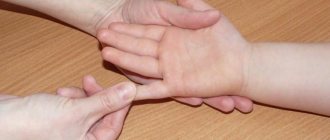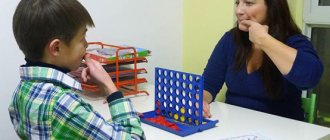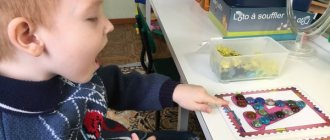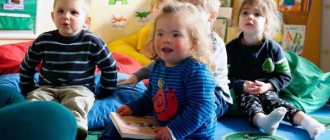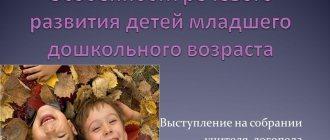workshop for parents of children attending a speech center at a preschool educational institution “Your own speech therapist!”
It is necessary to move from simple types of speech activity to more complex ones: first, the child simply repeats words after an adult, and then he himself names objects, actions based on pictures, and performs grammatical exercises in a playful way. You can practice clear pronunciation in poems, tongue twisters and stories based on pictures.
Before class, it is necessary to create positive motivation: it is important to explain to the child the importance of correct pronunciation.
Be sure to praise your child for completed tasks, for his achievements, and celebrate the child’s successes. Don't focus on failures, but purposefully overcome them.
2.
- So, let's learn to play! First, you need to collect speech material to automate a particular sound:
find and cut out pictures with automated sound from old magazines or select pictures from “Loto” (you may have at home lotto “Children’s”, “Pick and Name”, “Seasons”, “Animals” or others);
you can use the presentations provided to you by your speech therapist;
you can buy ready-made speech therapy notebooks for homework;
draw a schematic representation of objects on separate cards;
At the first stage, the sound is automated in syllables, but, as a rule, we do not stay long at this work. Still, semantic exercises should prevail over purely mechanical repetition and pronunciation. Therefore, let’s look at examples of didactic games to reinforce sounds in words:
These could be games such as:
“Labyrinths” (naming pictures arranged in a certain sequence; you can use small figures in the game that “walk” through the pictures)
“Guess it” (guessing objects based on their characteristics or actions)
“Echo” (remember and repeat the words from the pictures after me)
“Photographer” (remembering as many pictures as possible previously viewed)
“Telegraph” (pronouncing words with clapping, tapping them syllable by syllable)
“Guess the word”/“Come up with a word” (recognizing or inventing words by a given initial syllable or by the first sound)
variants of the game “Magic Wand” (lexical and grammatical exercises: “One - many” - formation of a plural noun; “Hide and Seek”, “A lot of things” - the use of noun endings in R.p.; “Call it affectionately”, “Big-small” – noun formation using diminutive suffixes)
“Count it” agreement of nouns with numerals (you can use counting sticks, number cards, magnetic numbers)
The next step is to automate the sound in sentences. Just making up suggestions is boring! Therefore, you will have to be creative to keep your child interested. You can play out such tasks in the following way: an adult and a child come up with proposals based on the pictures in turns (for each proposal they come up with, the player receives a “forfeit” - for example, a button).
Speech therapy training for parents
Scenario for family speech therapy training
"Gymnastics for mind and body"
The effectiveness of work in a speech therapy group largely depends on constructive interaction with the families of students.
In accordance with the requirements of the Federal State Educational Standard, parents (legal representatives) must be provided with assistance in raising children, protecting and strengthening their physical and mental health, developing individual abilities and the necessary correction of disorders and development. At the same time, work with parents should have a differentiated
approach, take into account social status, family microclimate, parental requests and the degree of interest of parents in the activities of the preschool educational institution.
The peculiarities of the modern family require detailed study of this link in the correctional and developmental process, to quickly respond to changes in the social composition of parents, their educational needs and educational requests.
One of the innovative areas in the system of work of families and preschool institutions in the modern educational process is the organization and conduct of speech therapy trainings. The peculiarity of this form of work is that in the course of joint communication, parents learn to interact effectively with the child, using the most significant forms and methods of activity for a given age.
An integrated approach to improving the pedagogical culture of parents will significantly diversify their relationships with children and optimize interaction with kindergarten teachers, allowing them to bring the correctional educational process to a qualitatively new level.
Life is a system of movements. Movement has a beneficial effect on the entire body and, especially, on brain activity. It has been proven that physical activity helps to increase mental performance, speech development, and the full formation of voluntary movements and actions that underlie human motor behavior. Many people are sure that thinking and learning are concentrated only in the head. On the contrary, our body plays a unifying role in all intellectual processes, from early childhood to old age. Kinesiology is a scientific and practical discipline that studies muscle movement in all its manifestations. The main idea that kinesiologists promote is that developmental work should be directed from movement to thinking, and not vice versa. Kinesiological exercises make it possible to use those parts of the brain that were not previously involved in learning and solve the problem of failure.
The development of a child with dysarthria from the first days of life differs from the development of normally developing children. They pronounce words illegibly, eat poorly, master self-care skills late and with difficulty, somewhat later than their peers begin to jump on one or two legs, run awkwardly, motor clumsiness of the hands is especially noticeable in art classes, they cannot learn to ride a bicycle for a long time, ice skating and skiing. Motor incompetence is clearly noticeable in physical education and music classes, where children lag behind in tempo, rhythm of movements, as well as in switching movements. In addition, in this category of children, the correct execution of complex motor acts is hampered by underdevelopment of static and dynamic coordination of movements. It is expressed in the presence of difficulties in maintaining a given position, tremor of the fingers, deviations of the body to the sides, and balancing with the hands.
